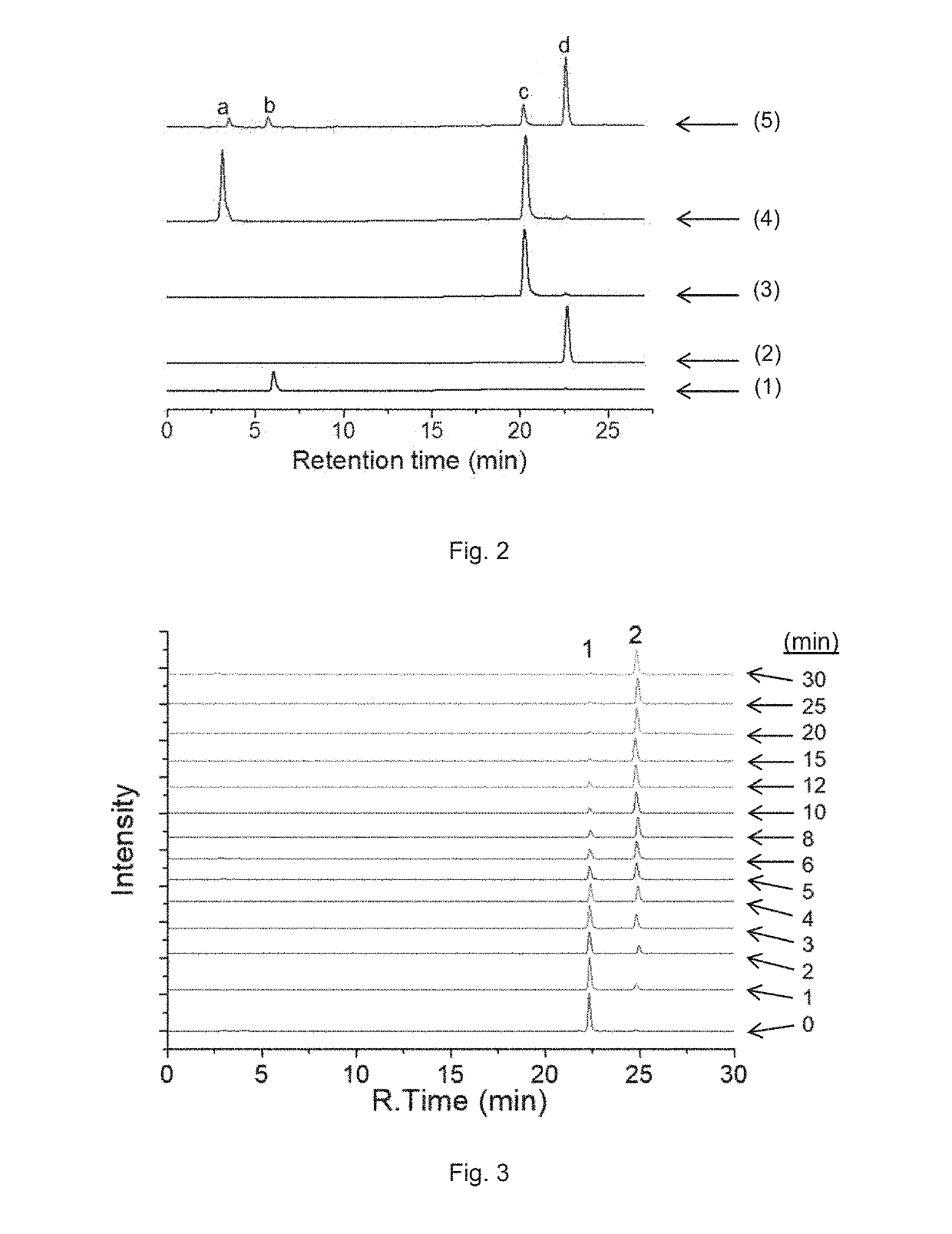Platinum complex, its preparation and therapeutic use
- Summary
- Abstract
- Description
- Claims
- Application Information
AI Technical Summary
Benefits of technology
Problems solved by technology
Method used
Image
Examples
example 1
Preparation of Complex A
[0191]Complex A of the present invention was prepared according to Reaction scheme 1:
[0192]To the mixture of pyropheophorbide a (PPA, 50 mg, 0.093 mmol) and N-hydroxysuccinimide (NHS, 15 mg, 0.13 mmol) in DMSO (3 mL), 1-ethyl-3-(-3-dimethylaminopropyl) carbodiimide hydrochloride (EDC, 30 mg, 0.15 mmol) were added. The reaction mixture was stirred overnight at room temperature, and then the resulted solution was added to ice-cold 30 mL deionized water dropwise. The precipitate was collected by centrifugation and washed twice by ice-cold water. The precipitate was further lyophilized and redissolved in DMSO (3mL). Oxaliplatin, i.e. [Pt(DACH)(ox)(OH)2], (40 mg, 0.093, synthesized as described in J. Z. Zhang et al., Chemistry—A European Journal 2013, 19(5), 1672-2676) was added to the solution, and the mixture was stirred at 60° C. overnight. The resulted solution was added to ice-cold 30 mL deionized water dropwise. The obtained precipitate was collected by cent...
example 2
Preparation of Complex B
[0194]Complex B of the present invention was prepared according to Reaction scheme 2:
[0195]Rhodamine B (0.4 g, 0.84 mmol) was dissolved into 10 mL acetonitrile. Then N-hydroxysuccinimide (NHS, 144 mg, 1.26 mmol) and N, N′-dicyclohexylcarbodiimide (DCC, 207 mg, 1.00 mmol) were added into the solution. The mixture was stirred overnight at room temperature. After that, the byproduct dicyclohexylurea (DCU) was removed by centrifugation and the rhodamine B NHS ester was obtained by vaporizing all the solvent. This rhodamine NHS ester was directly used in the next step without further purification. Rhodamine NHS ester (80 mg, 0.14 mmol) and oxaliplatin (180 mg, 0.41 mmol) were added into 2 mL DMSO. The mixture was stirred at 120° C. for 8 h. After reaction, the unreacted oxaliplatin was removed by centrifugation and the DMSO solution was added into 100 mL cold diethyl ether (Et2O). Red precipitate was thus formed. The red precipitate was collected by filtration fol...
example 3
Preparation of Complex C
[0197]Complex C of the present invention was prepared according to Reaction scheme 3:
[0198]Boc-glycine NHS ester (272 mg, 1 mmol) and oxaliplatin (431 mg, 1 mmol) were added into 2 mL DMSO. The mixture was stirred overnight at 60° C. After reaction, a clear DMSO solution was obtained and the DMSO solution was then added into 100 mL cold Et2O to induce the formation of precipitate. The white precipitate was collected by centrifugation and then dissolved in a mixture of trifluoroacetic acid (TFA) and dichloromethane (1 mL, v / v, 1:1). This mixture was stirred at room temperature for 30 min. After that, the solvent was vaporized and then the residual was washed with 30 mL Et2O for twice. After drying in vacuum, [Pt(DACH)(ox)(TFA− NH3+CH2COO)(OH)] was obtained as white solid. [Pt(DACH)(ox)(TFA− NH3+CH2COO)(OH)] (60 mg, 0.1 mmol) was dissolved in 1 mL DMF. 6-Carboxyfluorescein N-hydroxysuccinimide ester (24 mg, 0.05 mmol) and trimethylamine (10 mg, 0.1 mmol) were a...
PUM
 Login to View More
Login to View More Abstract
Description
Claims
Application Information
 Login to View More
Login to View More - R&D
- Intellectual Property
- Life Sciences
- Materials
- Tech Scout
- Unparalleled Data Quality
- Higher Quality Content
- 60% Fewer Hallucinations
Browse by: Latest US Patents, China's latest patents, Technical Efficacy Thesaurus, Application Domain, Technology Topic, Popular Technical Reports.
© 2025 PatSnap. All rights reserved.Legal|Privacy policy|Modern Slavery Act Transparency Statement|Sitemap|About US| Contact US: help@patsnap.com



